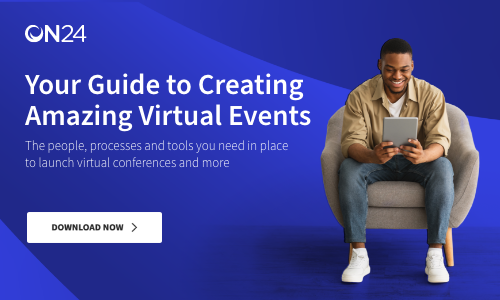Virtual events can potentially boost marketing performance, whether you’re aiming to grow your audience or generate new leads. This is largely because virtual events are a great format for stimulating engagement, perfect for developing stronger relationships with attendees and demonstrating your value.
However, to maximize the engagement opportunities presented by virtual events, you need to use virtual event technology effectively. We’ve put together a full guide to doing just that so you can maximize engagement at your next virtual event.
How ON24 Technology Can Enhance Virtual Engagement

The ON24 Intelligent Engagement Platform is designed to make engaging and personalized virtual events easy to host. It offers a range of features, including interactive event elements, content personalization tools and an in-built analytics dashboard, all of which can help you build more impactful events and keep track of valuable engagement data.
The team at Matillion, for example, uses ON24 to host a virtual event that generated 100,000 minutes of audience engagement, contributing to significant overperformance against their pipeline targets.
Understanding Engagement in Virtual Events
Engagement in virtual events refers to the different ways attendees can get involved. On a basic level, attendance itself can be classified as engagement. However, virtual event engagement is a term usually describing activities like CTA clicks, questions asked, polls completed, or engagement-driven activities — like virtual breakout rooms — that participants participated in during the event.
Driving engagement is often a core objective for businesses hosting virtual events. This is partly because keeping an audience engaged maximizes the value they get from the content, but it’s also useful because it can generate first-party data.
This data illuminates the content formats and topics that attendees found most interesting or relevant, which can provide directional insights for the marketing and sales departments. In other words, analyzing engagement data from a virtual event can lead to more effective engagement strategies elsewhere in the business.
Choosing the Right Virtual Event Technology

Choosing the right event hosting and management technology is essential to maximize engagement during a virtual event.
Key Features to Look For
The ideal virtual event platform that drives lots of engagement will have a comprehensive suite of features designed specifically to boost and analyze audience interactions, including:
-
- Interactive elements: Integrating polls, live Q&A sessions, event chats, and virtual breakout rooms is essential for creating engagement opportunities.
-
- Templatization: A highly customizable event template builder allows you to brand your event effectively and quickly create new events.
-
- Scalability: Even if you’re only starting with small virtual events, your chosen platform should be fully scalable to ensure it’s futureproof.
-
- On-demand playback: This feature allows you to host virtual events in an on-demand format after the live event has finished, allowing for continuous engagement opportunities.
-
- Analytics: An in-depth engagement analytics dashboard that tracks a range of metrics can help you extract a lot of value from the engagement data you collect.
Choosing a platform with all of these features will prepare you to plan, host, and analyze events that reliably stimulate high engagement.
Boost Engagement with ON24
The ON24 platform includes all of the key features you need to maximize audience engagement during virtual events. You can use it to build personalized event experiences that integrate diverse interactive elements, and the built-in analytics engine allows you to track audience engagement across various touchpoints to get valuable insights.
It also offers several features that open up opportunities to boost engagement after your event finishes, including the ability to host an on-demand version on your website and AI-powered tools that make repurposing event content for other channels quick and easy.
Pre-Event Strategies for Engagement

From pre-event polls that identify the topics your audience cares about most to refined event registration processes that maximize attendance, there are plenty of opportunities to engage your audience before your event starts. Here are some top tips to boost pre-event engagement.
Personalize Invitations and Reminders
Using personalization in event invitations and reminders can drive higher registration rates and open up opportunities for engagement. With a tool like the AI-powered Analytics and Content Engine by ON24, you can segment your audience based on demographic traits or interests and then use those segments as the basis for personalization.
This will help ensure that the messaging and content you use in your pre-event communications are always relevant to the recipient, increasing the chance they’ll sign up to attend your event. The AI tools included in ACE make this personalization process possible at scale, generating custom messaging and more.
Custom Registration Pages
With the right landing page creation tool, you can create individualized virtual event registration landing pages for your different audience segments, with custom messaging, content and user experience (UX) features to suit each segment’s needs.
This ensures that every user you drive towards a registration page is met with relevant, resonant content aligned with their interests or preferences. As a result, custom virtual event registration pages can boost event sign-up rates and generate more engagement through your existing content.
Engaging Attendees During the Event

The majority of engagement opportunities come during the virtual event itself. These are some of the best ways to drive continuous engagement to keep your audience tuned in and generate valuable data.
Use Interactive Tools
Virtual event technology like the ON24 platform provides interactivity tools like polls, Q&A sessions, and live chat features, offering the perfect way to integrate audience engagement into your event content seamlessly. These interactive elements can supplement your main event content and get your audience involved during key sections or inserted strategically to re-engage your audience when you think their attention might be lapsing.
Gamification
Using gamification strategies in virtual events transforms a passive viewing experience into an engaging journey, often significantly boosting attendee participation. There are diverse gamification strategies to implement in your event, from virtual scavenger hunts encouraging event exploration to engagement leaderboards stimulating more interactions.
Multimedia Integration
The best virtual events use many different media formats, like presentations, speaker slots and videos. Each format has its own unique strengths, so a combination can ensure your event delivers effective, engaging content. For example, live speaker slots are great for discussing complex topics, while videos are better suited to showing off product features.
Breakout Sessions and Networking
Virtual events, especially those that run for a full day or longer, can benefit from dedicated breakout sessions. These sessions are primarily useful for giving the audience an opportunity to take a breather from the event content but can also facilitate networking between attendees.
Post-Event Engagement Strategies

Even after your virtual event finishes, there are ways to continue engaging with your audience and driving more value. These are three of the best post-event engagement strategies.
Follow-Up with Attendees
In the days following your event, send follow-up emails to attendees to engage with them while your event is still fresh in their memory. You can use these follow-ups to deliver more content to your audience, personalizing your approach based on your segmentation strategy to maximize results.
Collect and Analyze Feedback
Post-event, it’s also useful to gather feedback from attendees to get direct insights that you can use to improve your approach to virtual events in the future. This data, collected through surveys or feedback forms sent in email campaigns, can provide critical information that you can use to adjust your virtual event strategy and optimize your marketing campaigns.
Maintain Community Engagement
In the periods between virtual events, you can continue to engage your audience by holding activities or fostering digital communities. Using your social media accounts to start discussions about trending topics in your sector is a great way to provide opportunities for direct engagement with potential leads.
Leveraging Data and Analytics

One of the best ways to improve results over time is to take a diligent approach to collecting and analyzing virtual event data.
Importance of Data Collection
First-party data is essential for understanding how your audience engaged with your event. Virtual event platforms that feature in-built analytics dashboards like ON24 can provide critical insights into what content formats, topics and interactive elements generated the most engagement. You can use these insights to steer your marketing strategy, creating more successful campaigns.
Using Analytics Tools
While the most valuable data will come from your dedicated event analytics tool, you can also use other analytics platforms to gather data that informs future strategy. Your website analytics platform, like Google Analytics, can provide valuable insights into what content topics attract the most attention, and poll results can indicate your audience’s key pain points or problems to be solved.
Applying Insights to Future Events
Regardless of what sources you use to collect engagement data, the most important element of any analytics process is applying the insights to future strategies. A particularly useful method to consider is analyzing the first-party data you collect on a segmented basis to get insights about what content formats and topics each of your key segments engages with most. You can then use this data to roll out personalized content campaigns.


